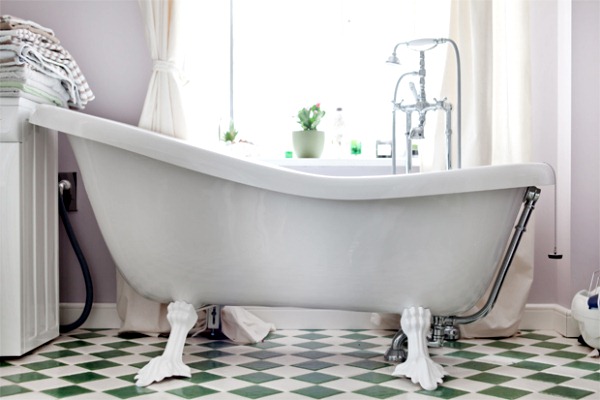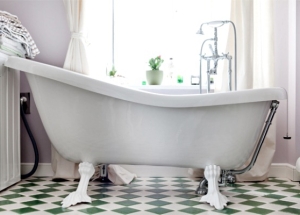While we are settling down our dwelling, we strive for maximum comfort and convenience. With special love and trepidation, we treat the design of the bathroom, the selection and installation of sanitary equipment, water supply and sewage systems, in the hope that they will function properly throughout the entire operational period. In order to exclude possible failures and failures in advance, to save our property or property of neighbors and not to be disappointed in the final result before independent communication, we recommend to study step-by-step instructions on the choice, installation of new equipment and carefully observe all requirements and recommendations, including ours.
Content
What are the baths?
Modern bathtubs are elegant and compact, reliable and durable, they can be made from various materials: steel, cast iron and acrylic.
Steel bath
A bath made of steel has enough light weight and good strength, but designers are very limited in the choice of the configuration of its execution, stopping their choice on the traditional form - in the form of a trough.
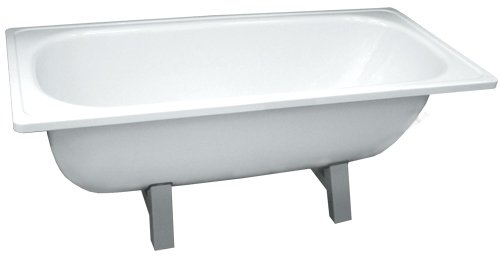
This bathroom quickly gives off heat, but this problem is easily solved by self-insulating with special materials. The main disadvantage of a steel bath is the possibility of damage to the coating even by light, accidental shocks. At the same time, simplicity of installation and reasonable price allow us to close our eyes to the existing shortcomings. About how to install a bathroom of steel, a little later.
Cast-iron bath
Cast iron baths, in contrast to steel products, are more reliable and durable. In old apartments even today one can meet a cast-iron bath, which faithfully served the owners for more than half a century and does not need to be replaced. A slightly yellowed model with cracked enamel can be restored. However, bathrooms, made with the latest technology from modern materials, are large in size and better keep the heat.
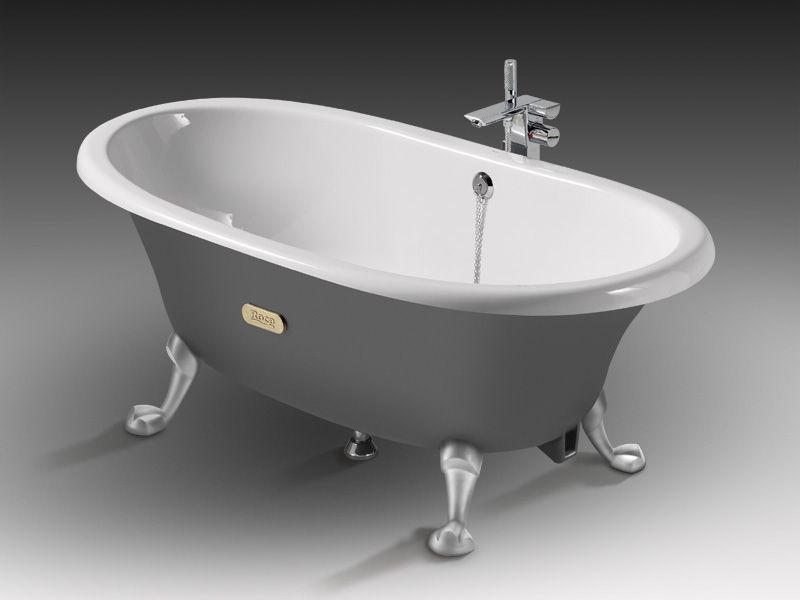
Acrylic bath
Acrylic baths please us with their elegance and variety of design, light weight and the ability to keep warm well. How to install such a bathroom? As easy as pie! After all, the kit with the product includes the necessary fasteners and instructions. This makes acrylic bathrooms the most popular and common among all sanitary products.
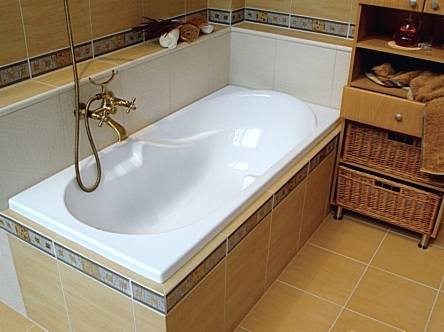
The only thing to consider when choosing such a product is strength - despite the fact that the bathroom can withstand the weight of a person and the pressure of water, it is not steel and not cast iron - it is fragile enough. Therefore, be wary of it during operation, avoid shocks, and when attaching the mixer, do not drop the bulky instrument into the bathroom.
Installing the bath yourself
The most difficult process when installing the plumbing equipment with your own hands is the assembly of the release. The complexity of the operation is determined, first of all, by the inconvenience of installation: whatever shape and configuration the bathroom is, the location of the water outlet is chosen precisely at the bottom of the product, which means that the distance from the floor surface and the plumbing is minimal, and it is here that the installation of the siphon .
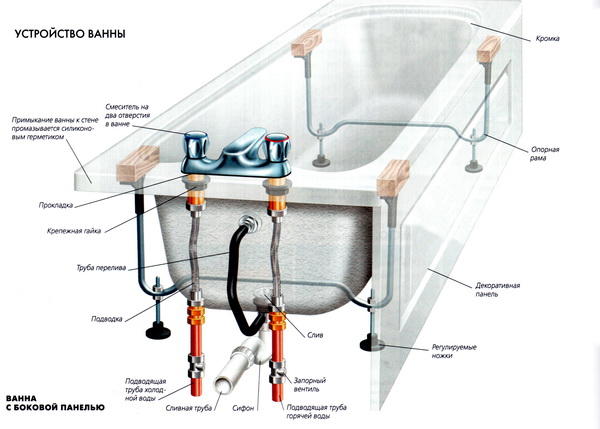
The pre-connection of the siphon to the sewer pipe will help you greatly simplify the work. To do this, you need to insert a rubber sleeve into the mouth of the pipe and insert a siphon pipe into it. Specialists recommend to lubricate the coupling inside and outside with a silicone sanitary sealant for the reliability of the joint.
After installing the siphon, proceed to the direct installation of the bathtub. You can invite an assistant, especially if you have to work with a cast iron or steel model. For successful work, one tightly presses the release of the siphon to the drain hole of the bath, the other inserts the neck and tightly tightens. Use a seal between the outlet of the siphon and the bottom of the bathtub. Place it outside. Pre-treat the seal with silicone sealant. Tighten the throat with effort and proceed to the overflow installation.
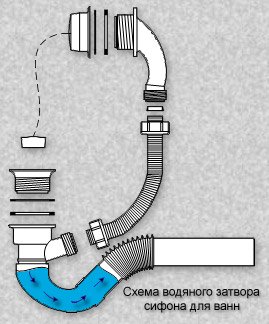
First, connect the overflow nozzle to the hose by fitting a plastic nut onto the hose, then a wedge-shaped gasket. At this moment it is important not to confuse - the narrowed part should be turned to the edge of the hose. Put it in a thin tube and tighten the nut, which will move the gasket into the tube and allow the hose to be fixed with maximum reliability. Then attach the second end of the overflow hose to the newly installed siphon, and at the end, tightly pressing the overflow to a hole specially designed for it, screw the neck along the guiding thread.
All the connecting elements can be fixed manually, except for the main outlet and the overflow neck - tighten them with a special fork key. If you do not have such a key, you can use pliers. To test the reliability of the connections, dial a small amount of water into the bath and let it out. Watch. Perhaps, somewhere you will find a leak. In this case, tighten the connection.
Full use of the installed sanitary equipment can be started after 6 hours - during this time the silicone will dry up.
Siphon constructions
Modern baths are characterized by a variety of siphon designs, among which there are even semi-automatic ones. The owner of such a plum does not have to drop his hand into soapy, hot or, vice versa, cold water in search of cork. To lift a cork and to lower water, it is necessary to turn only the washer located slightly above a water level in a bath.
However, such devices are worth buying for expensive, spacious baths, if you are the owner of a traditional model in a conventional bathroom, then a plastic set, which in a wide range can be found in the market of sanitary equipment, will be the optimal solution. Such components will last for several decades, and their installation does not cause special difficulties.
Among the models of siphons, it is possible to distinguish designs that have metal outlets, the attachment of which to the siphon body and overflow is carried out with the help of bolts. Installation in this case is even simpler, and the appearance is much more attractive.
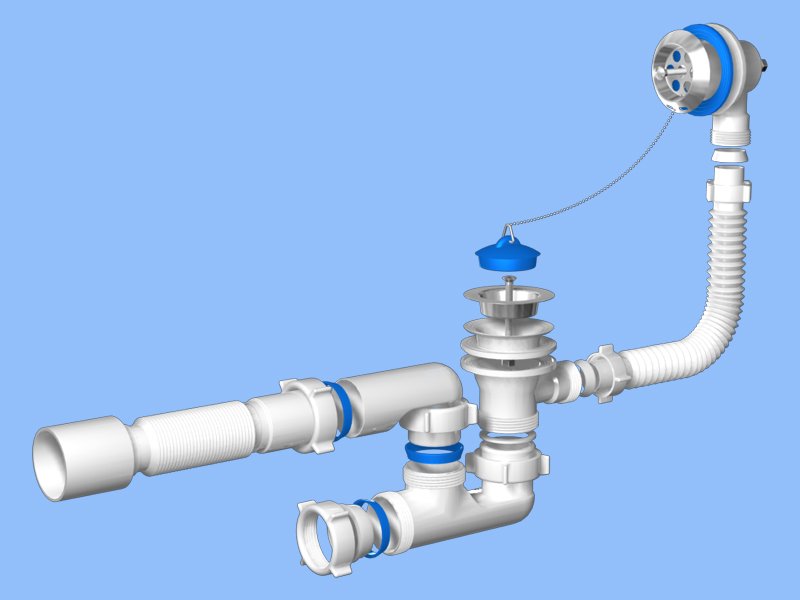
It should be noted that often manufacturers from China instead of stainless steel use nickel-plated iron, which after a few years is covered with rust. In addition, the kit includes bolts and nuts for fastening conventional or galvanized. Such parts are firmly attached to the siphon after a year and dismantled without damage, it becomes impossible.
Installation of a cast iron bath with your own hands
If you decide to install a cast-iron bath, then remember that you can not mount the siphon in advance. The large weight of the bath (approximately 100 kg) greatly complicates the process of installing the model in its place with the siphon attached to the sewer pipes in advance.
Installation of an acrylic bath is shown in detail in a video on youtube.
So, installing a bath by yourself is not a complicated process. It can even be performed by an unprepared person, it's enough to arm ourselves with simple tools that we are sure are on your workbench, to show a little patience, accuracy and attentiveness.
